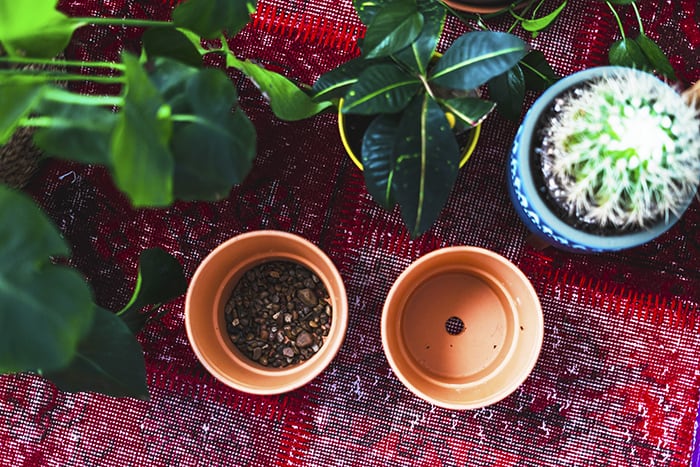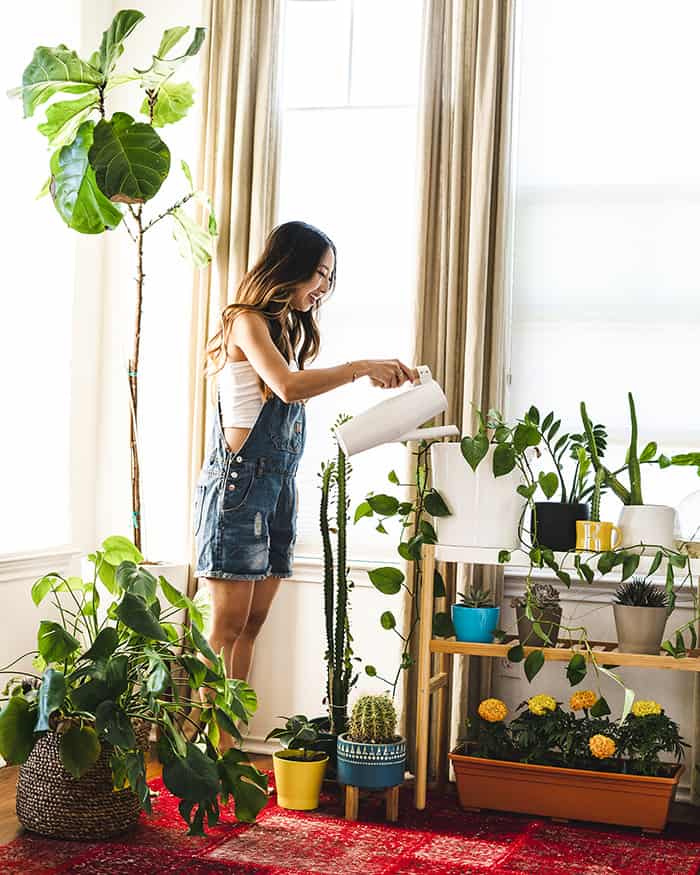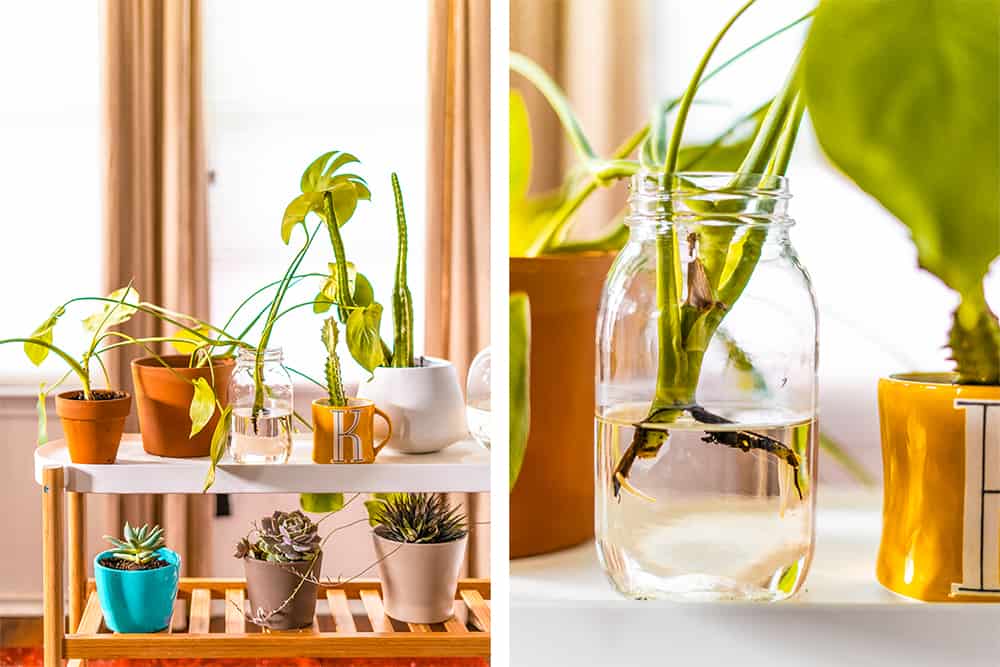In collaboration with Harvest Organics. Thank you for supporting the brands that support A Taste of Koko!
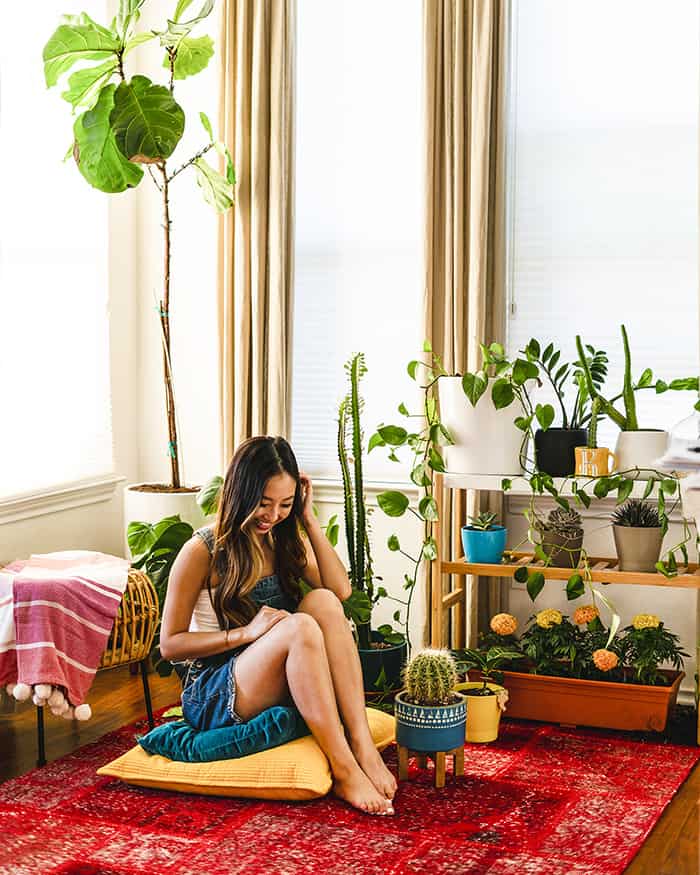
Hi, my name is Jane and I am a plant lady. I have over 30 plants inside my home and I can’t stop buying more. I wouldn’t even say that I have a green thumb but I’ve learned a lot in the last couple of years taking care of different houseplants.
SEE ALSO: 9 Best New Restaurants In Austin TX Right Now
Here’s my guide to the best houseplants that are low-maintenance, creating pot drainage, picking the best soil, maintaining and taking care of your plants, and propagating plant babies!
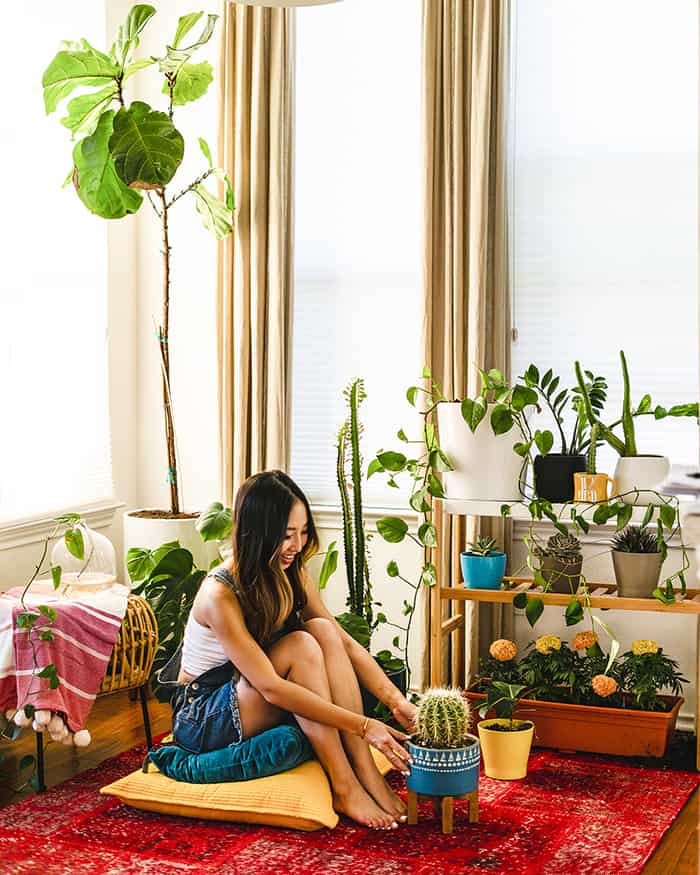
Table of Contents
1. CHOOSE LOW-MAINTENANCE HOUSEPLANTS
You want to select houseplants that are grown for indoors and for your space and environment. I really wanted a leafy palm plant and went through 4 different ones (thank goodness for Lowe’s incredible plant policy) but my house just wasn’t humid enough. If you don’t get a lot of light in your space, consider plants that require less light.
- Snake plant – super low-maintenance and forgiving if you forget to water it. The snake plant is great at purifying the air inside homes and releases oxygen at night, so place it in your bedroom.
- ZZ plant – I’ve had one of these for years and would often forget to water it, but it was always green and leafy!
- Pothos philodendron – see that long leafy vine in the photo above? That’s the pothos. I put mine at the top of the cabinets in the kitchen so the vines can crawl but forget to water it constantly and it’s done so well! Mine actually grew so many vines that I’ve propagated it into other pots.
- Succulents – the trick with succulents is to put the purple and orange ones outdoors and the green ones indoors. Use well-drained soil and only water when the soil is dry.
- Fiddle-leaf fig – the trick with the fiddle-leaf fig is to stay with a consistent watering schedule and keep the leaves clear of dust by wiping them with a cloth.
- Aloe vera – this succulent requires little watering and indirect sunlight so they do great in the bathroom.
- Jade Tiger Cactus (African Milk Tree) – I have several of these in my home and they’re very low-maintenance.
- Cactus – cactus in general is easy to take care of, just don’t overwater!
- Monstera deliciosa – I personally find the monstera plant easy to take care of and love the exotic look it gives a room.
- Rubber plant – I don’t have a rubber plant but they’re supposedly a low-maintenance plant because of its high drought tolerance.
Some might say air plants are super easy to take care of but for the life of me, I’ve gone through 10 different air plants in the last year and I just can’t keep them alive.
2. PICK POTS WITH DRAINAGE
Once you’ve picked your plants, it’s time to pick the pots. I’m a sucker for beautiful pots but not all beautiful pots have good drainage. Plants can get root rot if water doesn’t leave the pot, so you either need a pot with a drainage hole (above) or you need to build a drainage layer with the following:
- Stones/pea gravel
- Activated charcoal – much lighter in weight than pea gravel and is highly porous that absorbs excess water and helps prevent root rot. Activated charcoal also filters soil impurities, deters insects, resists mold, and eliminates odors.
- Packing peanuts – weigh almost nothing, allow for drainage!
- Coffee filter – don’t want dirt to keep falling through that drainage hole at the bottom of the pot? A coffee filter will keep all the contents inside the pot but still allow water to drain through.
3. SOIL SOIL SOIL
The most important thing for a plant (aside from water) is the soil. For indoor potted plants, you need to use potted soil, so I use Harvest Organics Potting Mix. Harvest Organics Potting Mix is made from a variety of compostable materials rerouted from landfills to create nutrient-rich soil. Even better, there are no added chemicals, synthetic additives, pesticides, or preservatives which means healthier plants, and healthier growing.
Harvest is the largest processor of yard and food waste in North America, managing to keep nearly 2,000,000 tons of waste from ending up in landfills. By recycling these scraps, Harvest turns waste into organic gardening products that then feed the earth to, in turn, feed people (e.g. vegetables, fruits, herbs, grasses, trees, flowers) to create a more sustainable planet.
By using Harvest Organic products, we become part of the #TheHarvestEffect, a movement to reduce waste and replenish the earth. The food that we throw away today could become the dirt that you grow produce in tomorrow.
Harvest Organics Potting Mix contains:
- Aged Pine Bark – Tiny shreds of aged pine bark, called fines, naturally encourage airflow and water drainage. Microorganisms like earthworms and healthy plant bacteria love these bark fines — and more microorganisms mean richer, more fertile soil.
- Perlite – The addition of organic perlite to our products improves water flow and aeration. Perlite helps plants thrive by preventing soil compaction — because when roots can strike deep, plants can grow strong.
- Peat Moss – Peat moss retains up to 20 times its weight in water, and it slowly releases moisture to keep plants from dehydrating. Peat moss also has aerating properties that allow air, water, and nutrients to easily penetrate roots.
4. MAINTAIN & TAKE CARE OF YOUR PLANTS
I’ve had several plants in my home that I’ve had for at least 3 years and haven’t grown a single inch. There’s more to plants than just watering – I didn’t even think to change out the soil or fertilize! Here’s a quick checklist:
- Fresh soil – make sure to check on your plants every 6 months to see if the pots need to be topped off with fresh soil or completely repot the plant.
- Fertilizer – indoor plants don’t need as much fertilizer as outdoor plants, so I’d do this every couple of months.
- Prune – regularly remove any dead or brown leaves from plants.
- Root rot – my newly propagated pothos was yellowing and it was because of root rot. I cut the plant and placed it in water to grow new roots before planting it back into the pot with a drainage layer.
5. PROPAGATION NEW PLANT BABIES
Consider yourself blessed with a green thumb if you can propagate your plants! I was so happy when I successfully propagated my pothos vine and monstera. My monstera plant grew so big that I was able to separate it into 5 different pots! I used a sharp knife to clip the stems right below the node. I recommend putting the cuttings in water so new roots will grow before planting in soil in a pot.
Happy planting!
